
The Formula 3000 International Championship was a motor racing series created by the Fédération Internationale de l'Automobile (FIA) in 1985 to become the final preparatory step for drivers hoping to enter Formula One. Formula Two had become too expensive, and was dominated by works-run cars with factory engines; the hope was that Formula 3000 would offer quicker, cheaper, more open racing. The series began as an open specification, then tyres were standardized from 1986 onwards, followed by engines and chassis in 1996. The series ran annually until 2004, and was replaced in 2005 by the GP2 Series.
Lola Cars International Ltd. was a British race car engineering company in operation from 1958 to 2012. The company was founded by Eric Broadley in Bromley, England, before moving to new premises in Slough, Buckinghamshire and finally Huntingdon, Cambridgeshire, and endured for more than fifty years to become one of the oldest and largest manufacturers of racing cars in the world. Lola Cars started by building small front-engined sports cars, and branched out into Formula Junior cars before diversifying into a wider range of sporting vehicles.

Formula racing is any of several forms of open-wheeled single-seater motorsport. The origin of the term lies in the nomenclature that was adopted by the FIA for all of its post-World War II single-seater regulations, or formulae. The best known of these formulae are Formula One, Formula E, Formula Two, Formula Three, regional Formula Three and Formula Four. Common usage of "formula racing" encompasses other single-seater series, including the IndyCar Series and the Super Formula Championship.

Judd is a brand of racing car engines built by Engine Developments Ltd., a company founded in 1971 by John Judd and Jack Brabham in Rugby, Warwickshire, England. Engine Developments was intended to build engines for Brabham's racing efforts, and became one of the first firms authorised by Cosworth to maintain and rebuild its DFV engines, but has since expanded into various areas of motorsport.
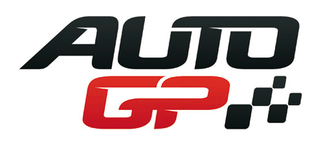
Auto GP, sometimes referred to as the Auto GP World Series and formerly known as both Euro Formula 3000 and the Euroseries 3000, was a European formula racing series.

The Lola T92/10 was a Group C sports car developed by Lola Cars as a customer chassis for the 1992 World Sportscar Championship season. It would be the final sports car built by Lola until their return in 1998.

The Lola B98/10 was a Le Mans Prototype built by Lola Cars International for use in the International Sports Racing Series, American Le Mans Series, and 24 Hours of Le Mans. It would be the first international sports car built by Lola since they briefly left the sport in 1992 following the Lola T92/10. It would be succeeded in 2000 by the Lola B2K/10.

The Lola B08/60 is a Le Mans Prototype built by Lola Cars International. It is the first closed-cockpit sports prototype built by Lola since the 1992 T92/10. It started competition in 2008, with Aston Martin being among the first customers for their entry into the LMP1 category in Le Mans Series, albeit entering under Charouz Racing System banner.
The British Formula 3000 championship, alternatively known as the British Formula Two Championship, was a competition for Formula 3000 held in the United Kingdom, active from 1989 to 1994 and in 1996. Several attempts to restart the series since then have met with failure.
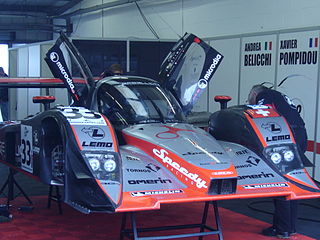
The Lola B08/80 is a Le Mans Prototype built by Lola Cars International. It is effectively the LMP2 version of the larger Lola B08/60; they are the first closed-cockpit sports prototypes built by Lola since the T92/10 of 1992. The B08/80 is optimised for the smaller engines and lighter weight of the LMP2 category in comparison to the larger and heavier B08/60.
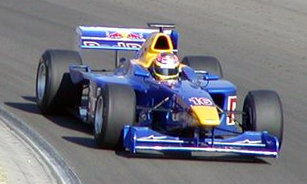
Formula 3000 (F3000) was a type of open wheel, single seater formula racing, occupying the tier immediately below Formula One and above Formula Three. It was so named because the cars were powered by 3.0 L engines.

The Dallara 3087 is a Formula 3000 car, first used in the 1987 International Formula 3000 season, with which the BMS Scuderia Italia team competed in the first race of the 1988 Formula One season. Driven by Alex Caffi, it failed to pass pre-qualifying with its fastest time being 18 seconds slower than the time set by Ayrton Senna for pole position. The BMS Scuderia Italia team replaced the car for the next race with Dallara F188 which was specifically designed for Formula One.
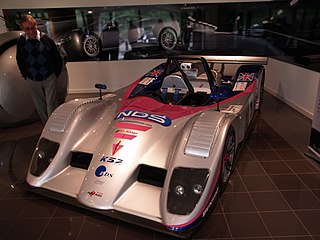
The Ascari A410 was a Le Mans Prototype built by Ascari Cars in 2000. The car, which was based on the Lola T92/10 Group C racing car, featured a 4-litre Judd GV4 V10 engine, and was used in European and international sports car racing events. In 2002, it was renamed as the Ascari KZR-1.
Louis "Wiet" Huidekoper was Dutch racecar designer and former technical director for the Opel DTM programme. His major career was in the international sports car racing arena.

The Dallara GP2/05 is an open-wheel formula racing car, developed by Italian chassis manufacturer Dallara, for use in the GP2 Series, a feeder series for Formula One. The GP2/05 was the first 1st-generation car used by the GP2 Series. The GP2/05 was used from 2005 to 2007, in keeping with the series philosophy of introducing a chassis every three years. As the GP2 Series is a spec-formula, the car was utilised by all teams and drivers in the championship.
The Ford Indy V8 engine is a naturally-aspirated, DOHC, V-8, Indy car racing engine, initially specially designed by Ford for use by Team Lotus, to compete in the Indianapolis 500; from 1963 to 1967. This is the engine that gave Jim Clark the victory in 1965 with his Lotus 38 chassis, Graham Hill victory in 1966 with his Lola T90 chassis, and A. J. Foyt the win at Indianapolis in 1967, in his Coyote 67 chassis.

The Lola B99/50 is an open-wheel formula race car chassis developed by British manufacturer Lola, for use in the International Formula 3000 series, a feeder-series for Formula One, between 1999 and 2001, until it was replaced by the new Lola B02/50 chassis for the new in 2002.
The Lola T92/00 is a highly successful open-wheel racing car chassis, designed and built by Lola Cars that competed in the CART open-wheel racing series, for competition in the 1992 IndyCar season. It was extremely competitive, winning 10 out of the 16 races that season, and clinching 14 total pole positions, including the opening round in Australia, and the special Marlboro Challenge event at Nazareth. It was mainly powered by the 800–850 hp (600–630 kW) Ford/Cosworth XB turbo engine, but some also used the Ilmor-Chevrolet 265-A V8 turbo engine, or the Buick Indy V6 turbo engine with this chassis. It powered Bobby Rahal to his third and final IndyCar World Drivers' Championship.
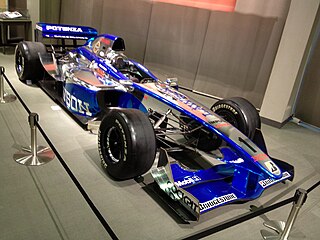
The Lola B06/51, also known as the Lola FN06, is an open-wheel formula racing car, designed, developed and built by Lola for the Japanese Formula Nippon championship series, in 2006.
The Lola T90/50 is an open-wheel formula race car chassis developed by British manufacturer Lola, for use in the International Formula 3000 series, a feeder-series for Formula One, in 1990.













